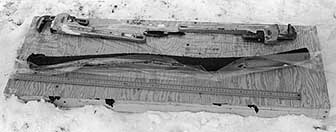|
Current
research in the Illinois State Museum's Palynology laboratories
includes studies in the Northern Great Plains region, with an
emphasis on short-term climatic change, drought, and fire. Results
indicate a highly variable climate and drought cycle. Work on very
ancient sites in Florida has demonstrated a link between ice-age
climates there and the North Atlantic region. Work in Illinois
includes analysis of several lakes in the northeastern part of the
State. One of these sites, Nelson Lake in Kane County, contains a
continuous record extending from the present to 17,000 years ago
just after retreat of the great Laurentide Ice Sheet when
tundra-like vegetation dominated the landscape. The vegetation was
far different from the mosaic of prairie and bur-oak groves that
occurred before European settlement or the corn and soybean fields
of today! Research is also ongoing from some sinkhole ponds in
Missouri that may yield information about the development of the
Ozark oak-hickory-pine forests.
 |
| Nelson Lake sediment core |
Curator of Botany, Dr. Eric Grimm, is coordinator of the North
American Pollen Database (NAPD), which archives fossil and modern
pollen from thousands of sites across North America. Funding for
the Database is from the National Oceanic and Atmospheric
Administration (NOAA) Paleoclimatology Program. Researchers from
throughout North America have contributed data to the database.
Data are entered and checked at the Illinois State Museum and then
sent to the National Geophysical Data Center (NGDC) in Boulder,
Colorado. The database is available from the NDGC Web site. The
pollen database is a valuable resource for international global
change research.
Next | Back |